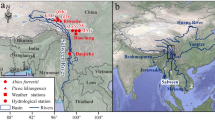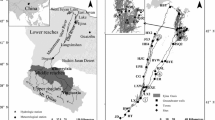Abstract
Existing streamflow reconstructions based on tree-ring analysis mostly rely on species from upland, mainly montane areas, while lowland species (generally plain) areas are rarely used. This limits the understanding of streamflow change history in the lowlands, which is an important basis for water resource management. This study focused on Populus euphratica stands located along the main stream, eastern and western tributaries in the lower reaches of the Heihe River basin (HRb), in arid northwestern China. We investigated how streamflow regulation interferes with riparian trees in lowlands when they used for streamflow reconstruction. Tree-ring width chronologies were developed and analyzed in conjunction with meteorological and hydrologic observation data. The results show streamflow regulation leads in sharp fluctuations in the streamflow allocation between the eastern tributaries and western tributaries. This resulted in instability of the correlation between streamflow at the two tributaries and at the Zhengyixia hydrologic station, with corresponding fluctuations in radial growth of poplar trees on the banks of the two tributaries and at the station. Streamflow regulation altered the natural patterns of seasonal streamflow below the station, changing the time window of poplar response. This study provides useful insight into tree-ring width based streamflow reconstruction in the lowlands.







Similar content being viewed by others
References
Ballesteros-Canovas JA, Koul T, Ahmad B, Bodoque J, Allen S, Guillet S, Rashid I, Alamgir S, Shah M, Bhat M, Alam A (2020) Recent flood hazards in kashmir put into context with millennium-long historical and tree-ring records. Sci Total Environ 722:1–9. https://doi.org/10.1016/j.scitotenv.2020.137875
Beguería S, Vicente-Serrano SM, Reig F, Latorre B (2014) Standardized precipitation evapotranspiration index (SPEI) revisited: parameter fitting, evapotranspiration models, tools, datasets and drought monitoring. Int J Climatol 34(10):3001–3023. https://doi.org/10.1002/joc.3887
Bunn AG, Korpela M, Biondi F, Campelo F, Mérian P, Qeadan F, Zang C (2019) dplR: dendrochronology program library in R. R package version 1.7.0
Chen F, Yuan Y, Trouet V, Büntgen U, Esper J, Chen FH, Yu SL, Shen MG, Zhang RB, Shang HM, Chen YP, Zhang HL (2022) Ecological and societal effects of central Asian streamflow variation over the past eight centuries. NPJ Clim Atmos Sci 5:27. https://doi.org/10.1038/s41612-022-00239-5
Cheng GD, Li X, Zhao WZ, Xu ZM, Feng Q, Xiao SC, Xiao HL (2014) Integrated study of the water-ecosystem-economy in the Heihe River basin. Natl Sci Rev 1:413–428. https://doi.org/10.1093/nsr/nwu017
Ejina Chronicles Committee (1998) Ejina chronicles. Fangzhi Press, Beijing, China
Cook ER, Palmer JG, Ahmed M, Woodhouse CA, Fenwick P, Zafar MU, Wahab M, Khan N (2013) Five centuries of Upper Indus River flow from tree rings. J Hydrol 486:365–375. https://doi.org/10.1016/j.jhydrol.2013.02.004
Gou XH, Deng Y, Chen FH, Yang MX, Fang KY, Gao LL, Yang T, Zhang F (2010) Tree ring based streamflow reconstruction for the Upper Yellow River over the past 1234 years. Chin Sci Bull 55(36):4179–4186. https://doi.org/10.1007/s11434-010-4215-z
Grissino-Mayer HD (2001) Evaluating crossdating accuracy: a manual and tutorial for the computer program COFECHA. Tree-Ring Res 57:205–221
Guo XY, Feng Q, Si JH, Xi HY, Zhao Y, Deo RC (2019) Partitioning groundwater recharge sources in multiple aquifers system within a desert oasis environment: implications for water resources management in endorheic basins. J Hydrol 579:124212. https://doi.org/10.1016/j.jhydrol.2019.124212
Li EG, Tong YQ, Huang YM, Li XY, Wang P, Chen HY, Yang CY (2019a) Responses of two desert riparian species to fluctuating groundwater depths in hyperarid areas of northwest China. Ecohydrology 12(3):e2078. https://doi.org/10.1002/eco.2078
Li JB, Xie SP, Cook ER, Chen FH, Shi JF, Zhang DD, Fang KY, Gou XH, Li T, Peng JF, Shi SY, Zhao YS (2019b) Deciphering human contributions to Yellow River flow reductions and downstream drying using centuries-long tree ring records. Geophys Res Lett 46(2):898–905. https://doi.org/10.1029/2018gl081090
Li Q, Liu Y, Meko DM, Nakatsuka T, Pan YN, Song HM, Liu RS, Sun CF, Fang CX (2022) Water resource management implications for a desert oasis from tree-ring δ18o variations in Populus euphratica in Northwest China. Water Resour Res 58(4):e2022WR031953. https://doi.org/10.1029/2022WR031953
Li X, Cheng GD, Ge YC, Li HY, Han F, Hu XL, Tian W, Tian Y, Pan XD, Nian YY, Zhang YL, Ran YH, Zheng Y, Gao B, Yang DW, Zheng CM, Wang XS, Liu SM, Cai XM (2018) Hydrological cycle in the Heihe River basin and its implication for water resource management in endorheic basins. J Geophys Res-Atmos 123(2):890–914. https://doi.org/10.1002/2017jd027889
Li X, Zheng Y, Sun Z, Tian Y, Zheng CM, Liu J, Liu SM, Xu ZW (2017) An integrated ecohydrological modeling approach to exploring the dynamic interaction between groundwater and phreatophytes. Ecol Model 356:127–140. https://doi.org/10.1016/j.ecolmodel.2017.04.017
Liao J, Wang T, Xue X (2012) Oasis evolution in the Heihe River Basin during 1956–2010. J Desert Res 5(32):1426–1441 ((In Chinese))
Liu SB, Chen YN, Chen YP, Friedman J, Hati J, Fang G (2015) Use of 2h and 18o stable isotopes to investigate water sources for different ages of Populus euphratica along the lower Heihe river. Ecol Res. https://doi.org/10.1007/s11284-015-1270-6
Liu Y, Song HM, An ZS, Sun CF, Trouet V, Cai QF, Liu RS, Leavitt S, Song Y, Qiang L, Fang CX, Zhou WJ, Yang YK, Jin Z, Wang YQ, Sun JY, Mu XM, Lei Y, Wang L, Zeng XL (2020) Recent anthropogenic curtailing of yellow river runoff and sediment load is unprecedented over the past 500 y. Proc Natl Acad Sci 117(31):18251–18257. https://doi.org/10.1073/pnas.1922349117
Liu Y, Sun JY, Song HM, Cai QF, Bao G, Li XX (2010) Tree-ring hydrologic reconstructions for the Heihe River watershed, western China since ad 1430. Water Res 44(9):2781–2792. https://doi.org/10.1016/j.watres.2010.02.013
Ma XH, Feng Q, Su YH, Yu TF, Jin H (2017) Forest evapotranspiration and energy flux partitioning based on eddy covariance methods in an arid desert region of northwest China. Adv Meteorol. https://doi.org/10.1155/2017/1619047
Meko DM, Friedman JM, Touchan R, Edmondson JR, Griffin ER, Scott JA (2015) Alternative standardization approaches to improving streamflow reconstructions with ring-width indices of riparian trees. The Holocene 25(7):1093–1101. https://doi.org/10.1177/0959683615580181
Meko DM, Woodhouse CA (2011) Application of streamflow reconstruction to water resources management. Dendroclimatology progress and prospects. Hughes MK, Swetnam TW & Diaz HF. Dordrecht Heidelberg London New York, Springer, pp 231–262
Peng XM, Xiao SC, Cheng GD, Tian QY, Xiao HL (2017a) Microcoring and dendrometer-detected intra-annual wood formation of Populus euphratica in the Ejina Oasis, northwestern China. Sci Cold Arid Reg 9(1):54–66. https://doi.org/10.3724/SP.J.1226.2017.00054
Peng XM, Xiao SC, Cheng GD, Xiao HL, Tian QY (2016) The water allocation history and its ecological impacts in the lower reaches of Heihe River around the 1940s, recorded in Populus euphratica tree ring. J Desert Res 36(1):206–215. https://doi.org/10.7522/j.issn.1000-694X.2016.00006(InChinese)
Peng XM, Xiao SC, Cheng GD, Xiao HL, Tian QY, Zhang QB (2017b) Human activity impacts on the stem radial growth of Populus euphratica riparian forests in China’s Ejina Oasis, using tree-ring analysis. Trees-Struct Funct 31:379–392. https://doi.org/10.1007/s00468-015-1287-z
Peng XM, Xiao SC, Yang B, Yu TF (2022) Water allocation and climate-impacted riparian forest dynamics in the Ejina Oasis, northwest China. Dendrochronologia 76:126001. https://doi.org/10.1016/j.dendro.2022.126001
Qin C, Yang B, Burchardt I, Hu XL, Kang XC (2010) Intensified pluvial conditions during the twentieth century in the inland Heihe River basin in arid northwestern China over the past millennium. Global Planet Change 72(3):192–200. https://doi.org/10.1016/j.gloplacha.2010.04.005
Schook D, Friedman J, Rathburn S (2016a) Flow reconstructions in the Upper Missouri River Basin using riparian tree rings. Water Resour Res. https://doi.org/10.1002/2016WR018845
Schook D, Friedman J, Stricker C, Csank A, Cooper D (2020) Short- and long-term responses of riparian cottonwoods (Populus spp.) to flow diversion: analysis of tree-ring radial growth and stable carbon isotopes. Sci Total Environ 735:139523. https://doi.org/10.1016/j.scitotenv.2020.139523
Schook DM, Carlson EA, Sholtes JS, Cooper DJ (2016b) Effects of moderate and extreme flow regulation on Populus growth along the Green and Yampa Rivers. Colorado Utah River Res Appl 32(8):1698–1708. https://doi.org/10.1002/rra.3020
Si JH, Feng Q, Cao SK, Yu TF, Zhao CY (2014) Water use sources of desert riparian Populus euphratica forests. Environ Monit Assess 186(9):5469–5477. https://doi.org/10.1007/s10661-014-3796-4
Speer JH (2010) Field and laboratory methods. Fundamentals of tree-ring research. Tucson, U.S.A., The University of Arizona Press, pp 72–105
St. George S (2010) Tree rings as paleoflood and paleostage indicators. Tree rings and natural hazards a state-of-the-art. Stoffel M, Bollschweiler M, Butler DR & Luckman BH. Dordrecht Heidelberg London New York, Springer 41: 233–239
Su YH, Zhu G, Feng Q, Li Z, Zhang F (2009) Environmental isotopic and hydrochemical study of groundwater in the Ejina Oasis, northwest China. Environ Geol 58(3):601–614. https://doi.org/10.1007/s00254-008-1534-3
Sun JY, Liu Y, Cai QF, Park W-K, Li BS, Shi JF, Yi L, Song HM, Li Q (2006) Climatic and hydrological changes of Ejin, Inner Mongolia, China during the past 233 years recorded in tree rings of Populus euphratica. Quat Sci 26(5):799–807 ((In Chinese))
Vicente-Serrano SM, Beguería S, López-Moreno JI (2010) A multiscalar drought index sensitive to global warming: the standardized precipitation evapotranspiration index. J Clim 23(7):1696–1718. https://doi.org/10.1175/2009jcli2909.1
Vicente-Serrano SM, Gouveia C, Camarero JJ, Beguería S, Trigo R, López-Moreno JI, Azorín-Molina C, Pasho E, Lorenzo-Lacruz J, Revuelto J (2013) Response of vegetation to drought time-scales across global land biomes. Proc Natl Acad Sci 110(1):52–57. https://doi.org/10.1073/pnas.1207068110
Wang NL, Zhang SB, He JQ, Pu JC, Wu XB, Jiang X (2009) Tracing the major source area of the mountainous runoff generation of the Heihe River in northwest China using stable isotope technique. Sci Bull 54(16):2751–2757. https://doi.org/10.1007/s11434-009-0505-8
Wang P, Yu JJ, Zhang YC, Liu CM (2013) Groundwater recharge and hydrogeochemical evolution in the Ejina Oasis, northwest China. J Hydrol 476:72–86. https://doi.org/10.1016/j.jhydrol.2012.10.049
Wang XM, Chen FH, Hasi E, Li JC (2008) Desertification in China: an assessment. Earth-Sci Rev 88(3):188–206. https://doi.org/10.1016/j.earscirev.2008.02.001
Xi HY, Feng Q, Si JH, Chang ZQ, Cao SK (2010) Impacts of river recharge on groundwater level and hydrochemistry in the lower reaches of Heihe River watershed, northwestern China. Hydrogeol J 18:791–801. https://doi.org/10.1007/s10040-009-0562-8
Xiao SC, Xiao HL, Peng XM, Tian QY (2014) Daily and seasonal stem radial activity of Populus euphratica and its association with hydroclimatic factors in the lower reaches of China’s Heihe River Basin. Environ Earth Sci 72:609–621. https://doi.org/10.1007/s12665-013-2982-y
Zhang JZ, Alexander MR, Gou XH, Deslauriers A, Fonti P, Zhang F, Pederson N (2020) Extended xylogenesis and stem biomass production in Juniperus przewalskii Kom. during extreme late-season climatic events. Ann for Sci 77(4):1–11. https://doi.org/10.1007/s13595-020-01008-1
Zhang QB, Li ZS, Liu PX, Xiao SC (2012) On the vulnerability of oasis forest to changing environmental conditions: perspectives from tree rings. Landscape Ecol 27:343–353. https://doi.org/10.1007/s10980-011-9685-0
Acknowledgements
The authors are grateful to the professor Qibin Zhang for valuable constructive suggestions and comments, the team members of Professors Shengchun Xiao and Qibin Zhang, for their help in tree-ring data preparation.. Meteorological data were obtained from the web sites of China Meteorological Data Service Center (http://data.cma.cn/en).
Author information
Authors and Affiliations
Contributions
XP: Conceptualization, Methodology, Software, Formal analysis, Investigation, Data Curation, Writing—Original Draft, Writing—Review & Editing, Funding acquisition; SX: Conceptualization, Formal analysis, Investigation, Writing—Review & Editing, Funding acquisition; BY: Conceptualization, Writing—Review & Editing, Funding acquisition; QT: Methodology, Investigation, Writing—Review & Editing; VVS: Writing—Review & Editing.
Corresponding author
Additional information
Publisher's Note
Springer Nature remains neutral with regard to jurisdictional claims in published maps and institutional affiliations.
Project funding:This work was supported by the National Natural Science Foundation of China (NSFC) (No. 42171167, 41701050, 42261134537); Key Laboratory Cooperative Research Project of CAS (Chinese Academy of Sciences); Inner Mongolia Autonomous Region Special Fund project for Transformation of Scientific and Technological Achievements (2021CG0046); and the Alxa League Science and Technology Project (AMYY 2021-19). Vladimir V. Shishov was supported by the Ministry of Science and Higher Education of the Russian Federation (FSRZ-2023-0007).
The online version is available at http://www.springerlink.com.
Corresponding editor: Tao Xu.
Rights and permissions
Springer Nature or its licensor (e.g. a society or other partner) holds exclusive rights to this article under a publishing agreement with the author(s) or other rightsholder(s); author self-archiving of the accepted manuscript version of this article is solely governed by the terms of such publishing agreement and applicable law.
About this article
Cite this article
Peng, X., Xiao, S., Yang, B. et al. Why lowland riparian trees are difficult to use for streamflow reconstruction. J. For. Res. 35, 59 (2024). https://doi.org/10.1007/s11676-024-01713-x
Received:
Accepted:
Published:
DOI: https://doi.org/10.1007/s11676-024-01713-x




